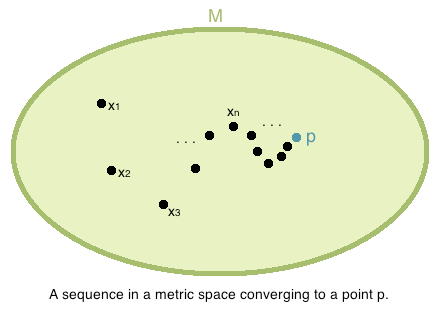Limits of Sequences in Metric Spaces
Recall that if a sequence of real numbers  is an infinite ordered list where
is an infinite ordered list where  for every
for every  . We will now generalize the concept of a sequence to contain elements from a metric space
. We will now generalize the concept of a sequence to contain elements from a metric space  .
.
Definition: Let  be a metric space. An (infinite) Sequence in
be a metric space. An (infinite) Sequence in  denoted
denoted  is an infinite ordered list of elements
is an infinite ordered list of elements  for all
for all  .
.
Finite sequences in a metric space can be defined as a finite ordered list of elements in  but their study is not that interesting to us.
but their study is not that interesting to us.
We can also define whether a sequence  of elements from a metric space
of elements from a metric space  converges or diverges.
converges or diverges.
Definition: Let  be a metric space. A sequence
be a metric space. A sequence  in
in  is said to be Convergent to the element
is said to be Convergent to the element  written
written  if
if  and the element
and the element  is said to be the Limit of the sequence
is said to be the Limit of the sequence  . If no such
. If no such  exists, then
exists, then  is said to be Divergent.
is said to be Divergent.
There is a subtle but important point to make. In the definition above,  represents the limit of a sequence of elements from the metric space
represents the limit of a sequence of elements from the metric space  to an element
to an element  while
while  represents the limit of a sequence of positive real numbers to
represents the limit of a sequence of positive real numbers to  - such limits we already have experience with.
- such limits we already have experience with.
For example, if  is any nonempty set,
is any nonempty set,  is the discrete metric, and
is the discrete metric, and  , then the sequence defined by
, then the sequence defined by  for all
for all  , then the sequence:
, then the sequence:

Furthermore, it's not hard to see that this sequence converges to  , i.e.,
, i.e.,  , i.e.,
, i.e.,  since for all
since for all  we have that
we have that  , so
, so  .
.
We will soon see that many of theorems regarding limits of sequences of real numbers are analogous to limits of sequences of elements from metric spaces.
The Boundedness of Convergent Sequences in Metric Spaces
If  is a metric space and
is a metric space and  is a sequence in
is a sequence in  that is convergent then the limit of this sequence
that is convergent then the limit of this sequence  is unique.
is unique.
We will now look at another rather nice theorem which states that if  is convergent then it is also bounded.
is convergent then it is also bounded.
Theorem 1: Let  be a metric space and let
be a metric space and let  be a sequence in
be a sequence in  . If
. If  is convergent then the set
is convergent then the set  is bounded.
is bounded.
- Proof: Let
 be a metric space and let
be a metric space and let  be a sequence in
be a sequence in  that converges to
that converges to  , i.e.,
, i.e.,  . Then
. Then  . So for all
. So for all  there exists an
there exists an  such that if
such that if  then
then  . So for
. So for  there exists an
there exists an  such that if
such that if  then:
then:

- Now consider the elements
 . This is a finite set of elements and furthermore the set of distances from these elements to
. This is a finite set of elements and furthermore the set of distances from these elements to  is finite:
is finite:

- Define
 to be the maximum of these distances:
to be the maximum of these distances:

- So if
 we have that
we have that  and if
and if  then
then  . Let
. Let  . Then for all
. Then for all  ,
,  . So consider the open ball
. So consider the open ball  . Then
. Then  for all
for all  so:
so:

- Therefore
 is a bounded set in
is a bounded set in  .
. 
Licensing
Content obtained and/or adapted from:














































